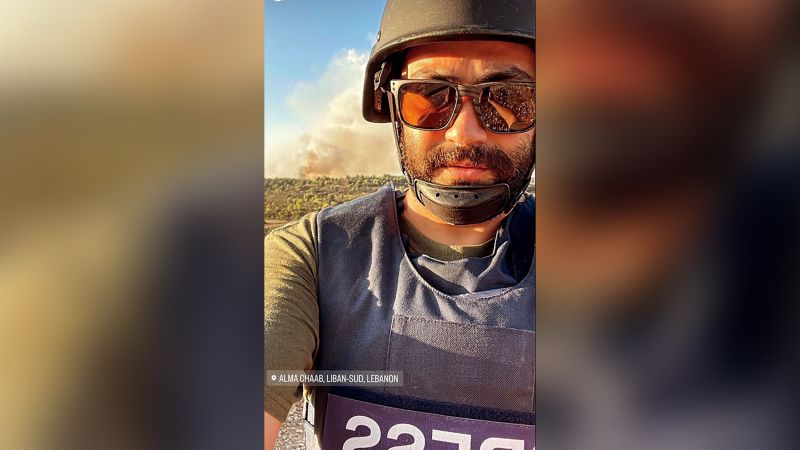
Israeli tank fire killed Reuters journalist in October attack, CNN analysis suggests
On Thursday, Reuters, AFP, Amnesty International and Human Rights Watch released investigations into the circumstances of the deadly strike. AFP and HRW claimed the strike was a “deliberate,” targeted attack by Israel on the journalists. In a statement to Reuters, Israel Defense Forces spokesperson Richard Hecht said: “We don’t target journalists.” He did not provide further comment, the news agency reported.
The Israel Defense Forces on Friday said that the October incident in which a Reuters journalist was killed is still “under review.”
AFP photographer Christina Assi had her leg amputated and remains in the hospital as a result of the strike, according to AFP.
Eylon Levy, a spokesperson for the Israeli government, said Thursday that he was “not familiar” with the new reports. “The guiding principle in Israel’s campaign against Hamas is we uphold the principles of international law regarding proportionality, necessity, distinction,” he said. “We target Hamas, we do not target civilians.”
Israel and Hezbollah were engaged in intense crossfire across the Lebanon-Israel border at the time.
Neither the Lebanese army nor the Iran-backed Hezbollah are known to have such ammunition in their arsenal.
“The shooter should have seen the journalists from the tank,” he added.
British weapons expert Chris Cobb-Smith said the photograph of the remnants of the shell clearly showed an “expended tank round.”
“Two projectiles hit the area of the media crews and from the damage to the wall, the location where Issam’s body ended up and from an analysis of the second crater, I believe the shots came from the area of the high ground just over the border,” said Cobb-Smith, referring to a foot-high wall seen in aftermath video near Abdallah’s body. Cobb-Smith said his analysis of the damage left by the projectile suggested that the attack came from a southeasterly direction.
Maher determined that the attack was likely a “supersonic event” due to the absence of an “approaching whoosh or whine, as you might see with artillery fire.”
Cobb-Smith’s theory that the shells travelled from the southeast would be consistent of the findings of the investigations released Thursday.
Israeli surveillance towers are seen in video of the attack, raising further doubt that Israel had not realized the tank crew was attacking journalists.
In it’s statement Friday, the IDF said, “On October 13, 2023, the terrorist organization Hezbollah launched an attack on multiple targets within Israeli territory along the Lebanese border,” the IDF said in a statement. “One incident involved the firing of an anti-tank missile, which struck the border fence near the village Hanita.”
“Following the launch of the anti-tank missile, concerns arose over the potential infiltration of terrorists into Israeli territory. In response, the IDF used artillery and tank fire to prevent the infiltration. The IDF is aware of the claim that journalists who were in the area were killed,” the statement continued.
“The area is an active combat zone, where active fire takes place and being in this area is dangerous. The incident is currently under review,” the IDF said.
IDF spokesperson Richard Hecht on October 14 called Abdallah’s death “a tragic thing,” without naming him directly or acknowledging Israel’s involvement. The same day, the IDF said: “A report was received that during the incident, journalists were injured in the area. The incident is under review.”
Al Jazeera has accused Israel’s military of “deliberately targeting the journalists to silence the media,” saying the attacks are a part of “a pattern of ‘repeated atrocities’ against journalists.”
Amnesty International’s investigation did not find “any indication that there were any fighters or military objectives at the site of the strikes.”
“Israeli forces had observation towers, ground elements, and air assets deployed to closely monitor the border. All of this should have provided sufficient information to Israeli forces that these were journalists and civilians and not a military target,” Amnesty said in its report.
“Our investigation into the incident uncovers chilling evidence pointing to an attack on a group of international journalists who were carrying out their work by reporting on hostilities. Direct attacks on civilians and indiscriminate attacks are absolutely prohibited by international humanitarian law and can amount to war crimes,” said Aya Majzoub, Amnesty International’s Deputy Regional Director for the Middle East and North Africa.
“The strikes were deliberate and targeted,” AFP said in its report. AFP global news director Phil Chetwynd said in the report, “AFP has been very clear that we will take all judicial avenues that we deem relevant and possible to ensure that we can get justice for Christina and Issam.”
Speaking Thursday in Washington, US Secretary of State Antony Blinken said that Abdallah’s death should be investigated. Blinken said it was his understanding that Israel had begun such an investigation and stressed the importance of seeing it through.
A Pentagon spokeswoman said earlier that the agency had not conducted its own assessment of Abdallah’s death but it continued to urge Israel to protect innocent civilians, including members of the press.
